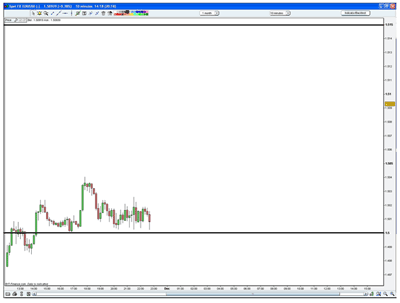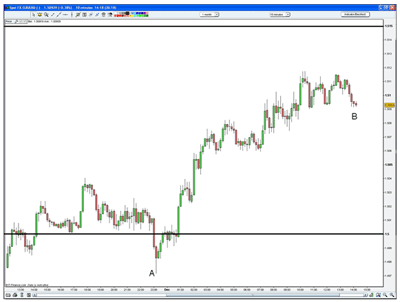Currency traders face a multitude of challenges when it comes to risk management. Increased volatility around scheduled macroeconomic announcements, or perhaps worse, surprise announcements or actions, can cause trades to be stopped out in a matter of seconds. Even in what may be considered the less volatile times of day, many traders still struggle with proper stop placement. Stops too close to the market and the trade may be over before it begins. Stops too far away and the losses can be monstrous. Even with a stop in place, in a highly leveraged market, it is still quite possible to lose more money than a trader may have even had in their account. Take for example the Federal Reserves quantitative easing announcement in March 2009. That day, many traders had stops placed on their trades when the market gapped in the neighborhood of 200 pips on many of the major pairs. When that happened, the stops were not filled at the pre-placed level, but the next available price, which in many cases constituted more money than was even available in their account, setting off collection calls from their brokers. When considering these challenges, traders may want to look toward limited-risk alternatives to the spot market in the form of bull spreads.
Bull Spreads: What Are They?
In traditional market lingo, the term “spread” can be somewhat ambiguous. In some instances, a spread can refer to the difference between two instruments. For example, the TED spread reflects the difference between interest rates on interbank loans versus short-term US government debt. To an options trader, spread may mean utilizing the same instrument but buying or selling at two different strike prices. An example of this would be a bull call spread, in which call options are purchased at a specific strike price, while also selling the same number of calls at a higher strike price on the same instrument at the same expiration. Throughout this article, the use of the term spread will refer to a short-term instrument available on the North American Derivatives Exchange (NADEX). NADEX spreads are simple, limited risk contracts that are settled against an underlying market and closely resemble bull or bear option spreads. Essentially, a spread is a price range between two strike prices, which create a floor and a ceiling for the contract. A typical daily spread on the pound/dollar currency pair could be phrased as GBP/USD 1.6400 to 1.6550, with an expiration at 3:00 pm. If I think the price of this pair is going up and I choose to buy, my maximum risk is the difference between my buy price and 1.6400. My maximum reward is the difference between my buy price and 1.6550. If I feel that the price of this pair is going down and I sell this spread contract, the maximum risk is the difference between the sell price and 1.6550. My maximum reward is the difference between my sell price and 1.6400. To clarify, below are a few potential outcomes if I decide to go long, or buy, this spread contract.
GBP/USD – 1.6400 to 1.6550 at 3:00 pm
Buy one contract at 1.6430
- If at expiration the GBP/USD is trading at 1.6600, the net profit would be 120 points, which is the difference between the top of the range (1.6550) and the buy price of 1.6430.
- If at expiration the GBP/USD is trading at 1.6300, the net loss would be 30 points, which is the difference between the buy price of 1.6430 and the bottom of the range (1.6400).
- If at expiration the GBP/USD is trading at 1.6500, the net profit is 70 points. The difference between the price at expiration and the initial buy price.
It is important to note that a trader does not have to hold the contract all the way to expiration and can close out at any point prior to 3:00 pm.
Why Trade Bull Spreads?
There are easily identifiable advantages for participating in spread trading, either as a stand-alone asset class, or as an addition to an existing currency strategy.
- Risk control – Because of the upper/lower boundaries, there is always a quantifiable level of risk that can be known before I place the trade.
- Fully margined – The total monetary risk associated with a trade is equal to the margin requirement. The boundaries protect the trade so it is impossible to lose more on a trade than was in the account to begin with. This can be a huge benefit in volatile times.
- No stops required – Even if price moves against the position initially, the trade is not stopped out and has time to work back in the trader’s favor. Most traders know the feeling of being stopped out after a trade is placed, only to watch it then immediately move back in what would have been their favor.
- Simple to use – Unlike option-spread strategies that require multiple “legs,” NADEX spreads are a single-leg option. This also limits the bid/ask differentials paid to one, rather than two or more.
- Same strategies – The same analysis can be used for spreads as what is used when trading the underlying directly.
NEXT: An Example of a Bull Spread Trade
|pagebreak|Example of a Bull Spread Trade as a Standalone Strategy:
Chart #1 is an example of a trading opportunity on the EUR/USD pair. The market had been moving up and after a slight pullback was holding along the support line (previously resistance) around 1.5000. Thinking that this may represent a good buy opportunity, I was looking to get long euro; however, there were several major announcements due out from both the Eurozone and the US and I was concerned that volatility may kick up quite a bit. For comparisons sake, I have broken out the difference between choosing a spot trade versus a spread trade.
On the spot market, the buy side price of this pair was 1.5011. Before I decide to buy, I have to consider where I would place my stop. The previous day’s low was 1.4973, so based on that support level I would most likely have a stop of about 45 pips in order to keep my closing order below support, with room for the market to breathe.
Referring to the NADEX spreads, there was a range listed as EUR/USD 1.5000-1.5150, expiring in 18 hours at 3:00 pm. The buy price on this spread was 1.5024, or about 13 pips over the spot market. The reason for the higher price on the spread trade was due to the optionality of the position. When price is near the floor of the spread, it will most often trade over the market price, when price is near the ceiling of the spread, it will most often trade below the spot price with the closest relationship between the two when price is in the middle of the spread. By buying at 1.5024 the absolute maximum risk on this position would be 24 pips (1.5024 buy price less the 1.5000 floor).
Spot trade versus spread, the numbers:
Buy Price:
- Spot – 1.5011
- Spread – 1.5024
Risk:
- Spot – 45 pip stop, or $450 on one standard contract (could be greater if slipped or gapped)
- Spread – 24 pips, or maximum of $240 absolute risk on the equivalent position size of spot trade
Margin Required:
- Spot – $3,002 at 50:1 margin
- Spread – $240 (margin is equivalent to the total risk of the trade)
Let’s take a look at how each of these trades would have resulted:
|pagebreak|As we can see from Chart #2 the market did move in our favor; however, it did so after a fairly significant initial drop.
Spot trade – The market did make an initial move against the long position and dropped to two pips below the previous day’s close, but was essentially a double bottom. Depending on our stop placement, the trade may have been stopped out; however, it would just be silly to put a stop that close to support and by giving the market room to breathe the trade would have most likely continued, albeit after a close call. Even being generous, our best case scenario would have been to close this spot trade around 1.5100 after it pulled back off the day’s high (which was not reached again within the next 24 hours) and the trade would have brought in 89 pips.
Spread trade – On the initial market dip, there were no concerns about getting stopped out as our risk was protected by the floor of the spread at 1.5000. Our risk was locked in at 24 pips as soon as we placed the trade and even if the market moved 100 pips against us, the trade was still live. At 3:00 pm Eastern, the spread closed in our favor at 1.5096 for a total gain of 72 pips.
Looking at these two trades, the natural question may be: “Why would I want to use a spread when I clearly made more on the spot trade?” That’s a valid question and one that illustrates the downfall of many traders, which is looking only at what can be made, rather than what is being risked. Amos Hostetter said it best, “Take care of your losses and the profits take care of themselves.” With that in mind, we need to take a look at all of the elements of this scenario.
Net Gain/Loss:
- Spot trade – +89 pips (making two bold assumptions that we would have not been stopped out and that we would have taken profit very near the highs
- Spread trade – +72 pips
Risk Amount:
- Spot trade – 45 pips, or $450 on one standard contract (again, not accounting for slippage or a sizable market gap)
- Spread trade – 24 pips maximum
Risk/Reward Ratio:
- Spot trade – 89 pips profit / 45 pips risk = just under 2:1
- Spread trade – 72 pips profit / 24 pips risk = 3:1
As we can see, from a risk to reward perspective, the spread trade was much more attractive than the spot trade. Additionally, if we take this one step further, we can look at the return on margin needed to establish the trade.
Margin:
- Spot trade – $3,002 (at 50:1)
- Spread trade – $240
Reward/Margin put up:
- Spot trade – $890 profit / $3,002 margin = 30% return on margin
- Spread trade – $720 profit / $240 margin = 300% return on margin
While not every situation is the same and there are no guarantees that any position will be profitable, it is easy to see that in many situations the risk to reward profile offered by a NADEX bull spread position may be more attractive than taking a position in the underlying market. Additionally, because the maximum risk is always set at the time the trade is placed, even if there is a large market moving event that takes place, a trader in a spread position will not have to worry about slippage, or worse, substantial market gaps jumping over the stop.
By Dan Cook, CEO, IGMarkets.com
Please remember that currency, futures, and options trading involve a significant amount of risk and may not be appropriate for everyone. Please ensure that you understand all risks prior to investing. Past performance is not necessarily indicative of future results.























